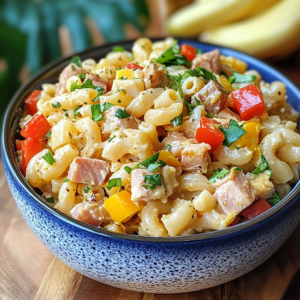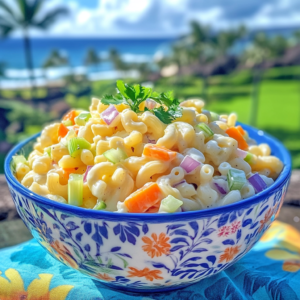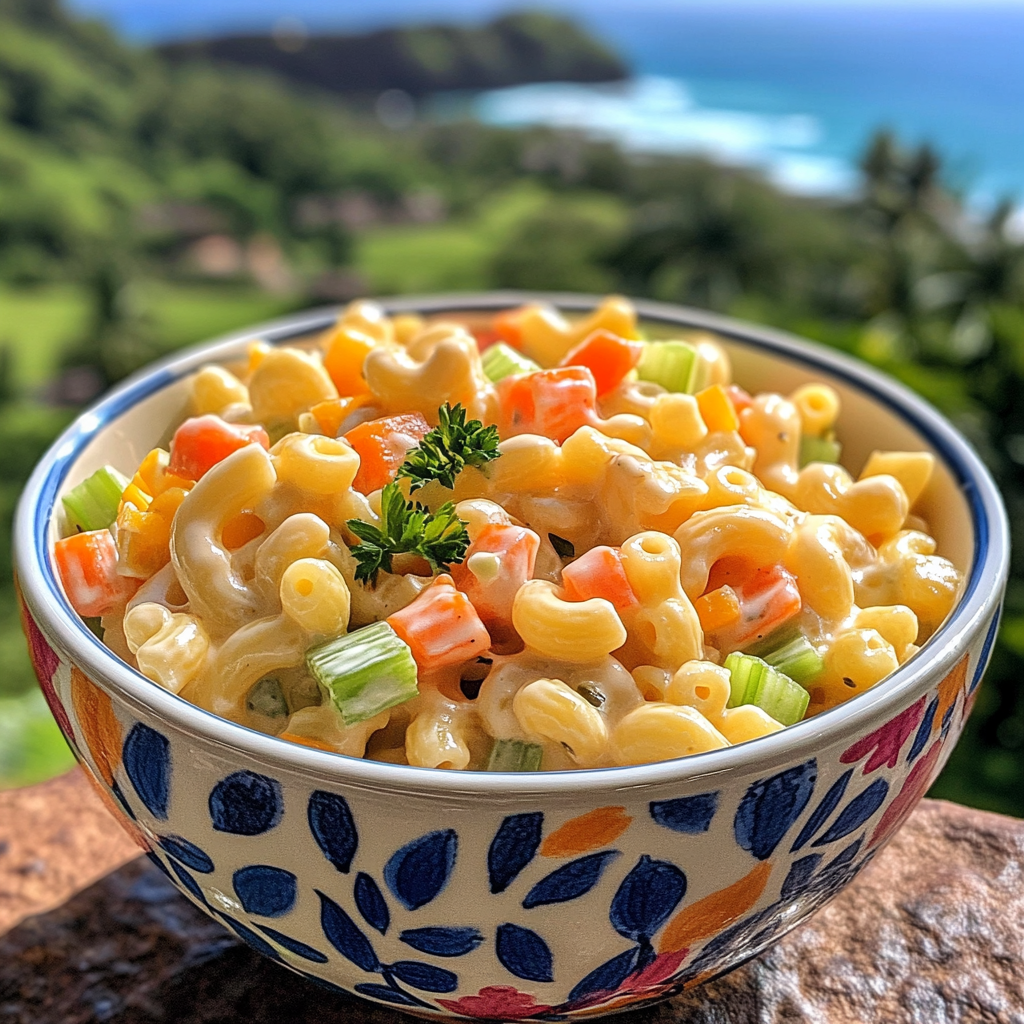Hawaiian mac salad is a beloved side dish that has become a staple of Hawaiian cuisine. Found at almost every plate lunch spot in Hawaii, this creamy, tangy, and slightly sweet salad holds a special place in the hearts of locals and visitors alike. But what makes Hawaiian mac salad taste so unique compared to other versions of macaroni salad? In this article, we’ll explore the history, ingredients, and preparation techniques that give Hawaiian mac salad its distinct flavor and texture. If you want to try making it at home, check out this Hawaiian Mac Salad recipe for step-by-step instructions.
The Origins of Hawaiian Mac Salad
Hawaiian mac salad is believed to have been influenced by classic American macaroni salad, which was brought to the islands by European immigrants in the early 20th century. However, over the years, local Hawaiian chefs adapted the recipe, creating a version that fits the island’s unique palate. It quickly became a part of the traditional Hawaiian plate lunch, served alongside rice, meats like teriyaki chicken, Pulled Beef Brisket, or loco moco, and sometimes even alongside other local favorites like poke or fried fish.
Hawaiian Mac Salad vs. Mainland Mac Salad
While Hawaiian mac salad has distinct characteristics, it’s interesting to compare it to the mainland version of macaroni salad. Mainland mac salad tends to include a wider variety of ingredients, such as celery, bell peppers, mustard, vinegar, and even pickles. It’s often more tangy due to the use of mustard or pickle juice, and it sometimes has a sharper flavor due to the addition of onions or peppers.
In contrast, Hawaiian mac salad is simpler and creamier, with its full-fat mayo base providing the dominant flavor. The sweetness in Hawaiian mac salad is also a key differentiator, creating a more balanced, mellow taste compared to the often tart mainland version. The simplicity of Hawaiian mac salad makes it a better complement to savory dishes commonly found in Hawaiian plate lunches.
Key Ingredients That Make It Unique
The ingredients used in Hawaiian mac salad are simple, yet they create a flavor that stands out. Here’s a breakdown of what makes the taste so different:
1. Full-Fat Mayonnaise
- Hawaiian mac salad uses a generous amount of full-fat mayonnaise, giving the dish its rich and creamy texture. Unlike other macaroni salads that may use lighter versions or add sour cream, Hawaiian mac salad sticks to the basics.
- Why It’s Important: The full-fat mayo adds a tangy richness, making each bite creamy without being overly heavy.
2. Simple Seasonings
- The seasonings in Hawaiian mac salad are minimal, often limited to salt, pepper, and a bit of sugar. Unlike other macaroni salads that may include mustard, vinegar, or a variety of herbs and spices, Hawaiian mac salad keeps it simple.
- Why It’s Important: This minimalist approach allows the creamy texture and slight sweetness to shine, giving it a more distinct taste.
3. Cooked Soft Macaroni
- One of the defining characteristics of Hawaiian mac salad is its soft texture. The elbow macaroni is cooked a bit longer than al dente, making it softer than typical pasta salads.
- Why It’s Important: The softer macaroni absorbs more of the mayo, resulting in a creamier and more cohesive salad.
4. Vinegar
- While vinegar isn’t always a visible ingredient in the final dish, it is sometimes added to the hot, drained macaroni before the mayo is mixed in. This helps the pasta absorb the tangy flavor, balancing the richness of the mayonnaise.
- Why It’s Important: The subtle tang from the vinegar gives the salad a slight zest without overpowering it, contributing to its unique flavor profile.
5. Sweetness
- Hawaiian mac salad typically has a hint of sweetness, often coming from a bit of sugar or sweet pickles. This is a key difference that sets it apart from mainland versions, which tend to be more savory or tangy.
- Why It’s Important: The sweetness adds depth to the salad, balancing the tangy and creamy flavors, and making it more enjoyable as a side dish.
Preparation Techniques That Matter
The way Hawaiian mac salad is prepared also plays a significant role in its distinctive taste:
1. Overcooking the Pasta
- As mentioned earlier, the macaroni is cooked until soft, not al dente. This may sound unusual, but it’s an intentional technique that helps the pasta better absorb the mayo and seasonings.
- Why It’s Important: The softer texture gives the salad a more comforting, cohesive feel, which is a signature of Hawaiian mac salad.
2. Letting It Chill
- Hawaiian mac salad is often prepared a few hours (or even a day) in advance, allowing the flavors to meld together as it chills in the fridge.
- Why It’s Important: This resting period enhances the flavor and texture, making the salad creamier and more flavorful as the pasta absorbs the mayo and seasonings.
3. Mixing in Stages
- Another technique used in making Hawaiian mac salad is mixing the ingredients in stages. First, the vinegar is added to the hot pasta, followed by the mayonnaise, sugar, and any other ingredients once the pasta has cooled slightly.
- Why It’s Important: This step-by-step mixing ensures that each ingredient is fully absorbed by the pasta, creating a consistent flavor throughout the salad.
The Role of Mac Salad in Hawaiian Culture
Hawaiian mac salad is more than just a side dish; instead, it’s a staple of local gatherings and celebrations. For instance, it’s commonly found at luaus, family barbecues, and community potlucks, making it a beloved comfort food among locals. The salad’s creamy, mild flavor not only complements the bold, savory flavors of traditional Hawaiian proteins like pulled beef brisket or teriyaki chicken but also helps create a well-rounded meal.
Moreover, mac salad often serves as a nostalgic dish for locals and visitors alike. Many people, in fact, associate it with their first plate lunch experience, which encapsulates the essence of Hawaiian cuisine. The simple, homey ingredients of mac salad reflect the island’s laid-back lifestyle, where food is meant to be both comforting and shared with loved ones. Ultimately, this connection to the community adds an extra layer of significance to why Hawaiian mac salad tastes different and holds a special place in local hearts.
Regional Variations of Hawaiian Mac Salad
While the classic version of Hawaiian mac salad is simple, there are regional variations across the islands that add a bit of flair:
1. Tuna Mac Salad

- Some versions of Hawaiian mac salad include canned tuna, adding a bit of protein and a savory twist.
- Why It’s Popular: It adds more substance to the dish, making it a heartier option for a plate lunch.
2. Potato-Mac Salad
- This variation mixes in cooked potatoes with the macaroni, creating a hybrid salad that’s creamy and filling.
- Why It’s Popular: The addition of potatoes gives the salad a slightly different texture and makes it more filling.
3. Pickled Veggies
- While classic Hawaiian mac salad may include simple vegetables like grated carrots or diced onions, some variations incorporate pickled vegetables for a tangy kick.
- Why It’s Popular: The pickled veggies add a zesty contrast to the creamy base, giving the salad a more dynamic flavor.
Variations of Hawaiian Mac Salad Across the Islands

While the basic recipe for Hawaiian mac salad remains consistent, each Hawaiian island has developed its own subtle twist on the dish:
Oahu’s Mac Salad: Known for its smoother texture, mac salad in Oahu often includes more mayo and is served very cold. It tends to be a bit sweeter, emphasizing the creamy and sweet balance that defines Hawaiian mac salad.
Maui’s Mac Salad: Maui’s version may include more vegetables, such as grated carrots, green onions, or even peas. The addition of these vegetables provides more texture and makes it a slightly heartier option.
Big Island’s Mac Salad: On the Big Island, some locals add a splash of soy sauce for a unique twist. This variation provides a slightly savory depth to the traditional recipe, offering a distinctive local flavor.
Kauai’s Mac Salad: On Kauai, mac salad may be served with a touch of hot sauce mixed in or served alongside for those who enjoy a bit of spice. This adds a zesty element to the creamy salad and pairs well with spicier plate lunch options.
Tips for Making Authentic Hawaiian Mac Salad at Home
If you want to recreate the authentic taste of Hawaiian mac salad at home, here are a few helpful tips:
a. Use Quality Mayonnaise: The mayonnaise you choose plays a crucial role in the final taste. Hawaiian mac salad traditionally uses brands like Best Foods (also known as Hellmann’s in other parts of the country), which gives the salad its signature creamy texture.
b. Cook the Pasta Longer: For the best texture, cook the pasta a bit longer than the package directions suggest. This results in softer macaroni, which is key to achieving the signature texture of Hawaiian mac salad.
c. Add the Vinegar While Pasta Is Hot: To ensure the macaroni absorbs the tangy flavor, add the vinegar to the pasta while it’s still warm. This step is crucial for creating the mild tang that balances the creamy richness of the salad.
d. Let It Chill: Don’t skip the chilling process! Refrigerate the salad for at least an hour before serving. This resting time allows the flavors to meld together, resulting in a more cohesive taste.
For those seeking gluten-free variations, Hawaiian mac salad can be enjoyed alongside gluten-free dinner recipes without missing out on flavor.
Serving Hawaiian Mac Salad
Hawaiian mac salad is more than just a side dish; it’s a part of the island’s culture. Here are some popular ways to enjoy it:
1. With Plate Lunches
- Hawaiian mac salad is a staple of the classic Hawaiian plate lunch, served alongside proteins like teriyaki chicken, Pulled Beef Brisket, or loco moco, or even miso salmon for a varied plate lunch.
2. At BBQs and Picnics
- It’s a common dish at Hawaiian BBQs and picnics, where its creamy texture and mild flavor complement grilled meats and other side dishes.
3. As a Comfort Food
- People often enjoy Hawaiian mac salad as a comforting meal, either cold or at room temperature. Its creamy, tangy, and slightly sweet flavor makes it a go-to choice for a simple, satisfying dish.
Why Hawaiian Mac Salad Complements Hawaiian Dishes
Hawaiian mac salad isn’t just a random side dish; rather, it’s a thoughtful addition to a Hawaiian plate lunch. Not only does its rich, creamy, and slightly sweet flavor balance the salty, savory taste of proteins like teriyaki beef, chicken katsu, or pulled beef brisket, but it also adds a contrasting element. Furthermore, the salad’s soft texture contrasts effectively with the crunch of fried foods, thus creating a well-rounded meal experience.
Moreover, its cooling effect pairs well with spicier Hawaiian dishes, such as spicy poke or chicken long rice, by adding a creamy touch. As a result, this balance of flavors and textures is what makes the Hawaiian plate lunch both satisfying and popular.
How Climate Impacts Ingredients and Flavor
The warm, tropical climate of Hawaii plays a significant role in shaping the flavors of its mac salad. Fresh, locally grown vegetables like carrots, onions, and celery are used, contributing a subtle sweetness and crunch. The consistent year-round warmth affects the flavor of the ingredients, often making them slightly sweeter compared to mainland produce.
Additionally, the humidity in Hawaii can impact the texture of ingredients. For example, pasta absorbs moisture differently in humid conditions, which can make it softer and more tender. This subtle difference in texture contributes to the distinctive creaminess of Hawaiian mac salad. Even the mayonnaise can taste richer due to the humidity’s effect on its consistency, creating a smoother and more integrated dressing.
Hawaiian cuisine’s reliance on locally available ingredients and the island’s tropical climate combine to create unique dishes like mac salad. The island’s environment not only shapes the produce but also the cooking techniques, further enhancing the salad’s flavor and texture. This natural influence is a key reason why Hawaiian mac salad has its own special taste.
Why Hawaiian Mac Salad Tastes Different
To sum up, the distinct taste of Hawaiian mac salad comes from its basic ingredients, unique preparation, and island culture. Soft, overcooked macaroni, full-fat mayonnaise, a hint of sweetness, and simple seasoning create its signature flavor. The result is a creamy, tangy, and slightly sweet salad. It’s not only delicious but also embodies the laid-back, unpretentious spirit of Hawaiian cuisine.
Next time you try Hawaiian mac salad, you’ll appreciate its distinct taste and understand why it’s a local favorite.
